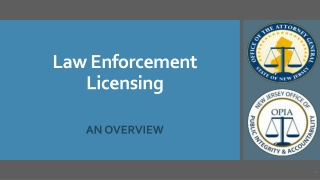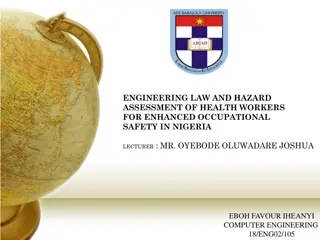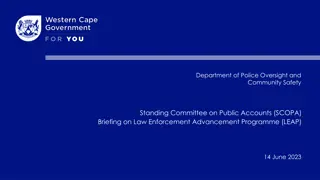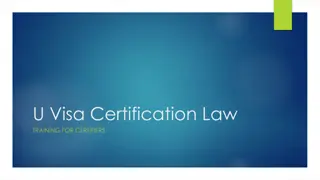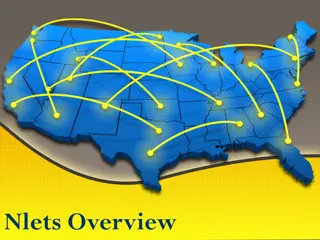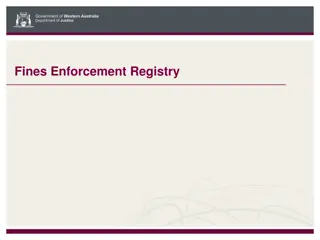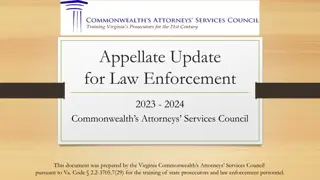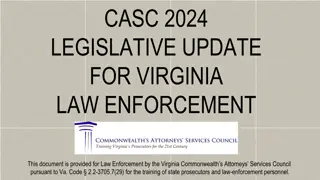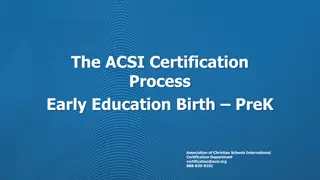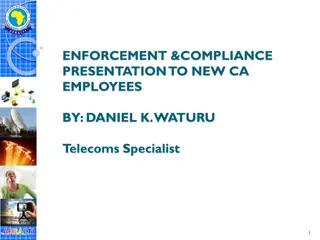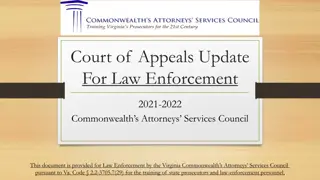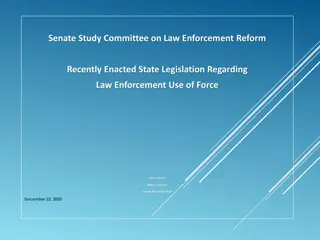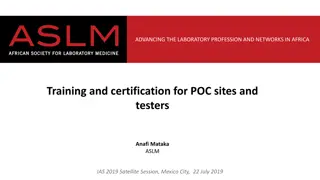MPCCF Law Enforcement Certification Program Overview
This content provides detailed information about the MPCCF Law Enforcement Certification Program in Missouri, covering topics such as standard components, assessment criteria, use of firearms/deadly force protocols, and general file organization. The syllabus outlines the requirements, assessments, and duties of a certification assessor, emphasizing the importance of compliance and adherence to professional standards in law enforcement agencies.
Uploaded on Sep 25, 2024 | 0 Views
Download Presentation

Please find below an Image/Link to download the presentation.
The content on the website is provided AS IS for your information and personal use only. It may not be sold, licensed, or shared on other websites without obtaining consent from the author. Download presentation by click this link. If you encounter any issues during the download, it is possible that the publisher has removed the file from their server.
E N D
Presentation Transcript
MPCCF Law Enforcement Certification Program Missouri Police Chiefs MPCCF Law Enforcement Certification Program Assessor slineback@mopca.com 573-636-5444
Syllabus Components of a Standard: Proof Standard Statement Analysis Required vs. Recommended Information
Syllabus (continued) Information Compliance: Bullets Non-bullets Highlighting: Written Directives Proofs
Syllabus (continued) General File Organization File Format: Standard Certification Standard Status Report (CSSR) Written Directives Proofs
Syllabus (continued) Specific Explanations Memo to File Time Sensitive Reports Analysis of Information Not Applicable by Function Wet Ink Waiver from Compliance
Syllabus (continued) Assessment Mock Assessment Final Assessment Duties of a Certification Assessor
Components of a Standard Components of a Standard: Proof Standard Statement Analysis
Components of a Standard What is a standard ?
Components of a Standard Standard A standard is a recognized, measurable, and necessary professional requirement setting a criteria for a specific process, function, service or procedure for law enforcement agency compliance. It establishes necessary provisions requiring adherence to the standard statement.
Components of a Standard 9.1 USE OF FIREARMS/DEADLY FORCE Proof: SOP governs the use of force by agency personnel and specifies that: An officer may use deadly force only when the officer reasonably believes that the use of deadly force is in defense of human life, including the officer s own life, or in the defense of any person in imminent danger of serious physical injury; the discharge of warning shots is prohibited; and all sworn officers shall receive documented instruction by certified instructors and shall demonstrate understanding in these directives prior to being issued or allowed to carry any weapon readily capable of deadly force, and at least annually thereafter. Proof: Provides sample of training program. A written directive governs the use of force by agency personnel and specifies that: a. An officer may use deadly force only when the officer reasonably believes that the use of deadly force is in defense of human life, including the officer s own life, or in the defense of any person in imminent danger of serious physical injury; b. The discharge of warning shots is prohibited; and c. All sworn officers shall receive documented instruction by certified instructors and shall demonstrate understanding in these directives prior to being issued or allowed to carry any weapon readily capable of deadly force, and at least annually thereafter. ANALYSIS: The purpose of this standard is to provide officers guidance in the use of force in life and death situations and to prevent unnecessary loss of life. Definitions of "reasonable belief", and "serious physical injury" should be included in the directive.
Components of a Standard What is a proof ?
Components of a Standard Proof A proof is what the agency will provide as evidence that the agency is in compliance with the standard statement. What does my agency do that I can use as evidence to show that we comply with the standard ?
Components of a Standard Proof 9.1 USE OF FIREARMS/DEADLY FORCE Proof: SOP governs the use of force by agency personnel and specifies that: An officer may use deadly force only when the officer reasonably believes that the use of deadly force is in defense of human life, including the officer s own life, or in the defense of any person in imminent danger of serious physical injury; the discharge of warning shots is prohibited; and all sworn officers shall receive documented instruction by certified instructors and shall demonstrate understanding in these directives prior to being issued or allowed to carry any weapon readily capable of deadly force, and at least annually thereafter. Proof: Provides sample of training program.
Components of a Standard Proof A proof can be: written documentation. an observation. Photographs Visual inspection an interview.
Components of a Standard Proof Almost all proofs will be written documentation to which at least one (1) proof per year of the assessment cycle shall be provided. Observations and interviews will usually take a supporting role to written documentation. Almost all proofs will require an interview.
Components of a Standard What is a standard statement ?
Components of a Standard Standard Statement A standard statement is the explanation of what is required to meet the criteria of the standard.
Components of a Standard Standard Statement 9.1 USE OF FIREARMS/DEADLY FORCE A written directive governs the use of force by agency personnel and specifies that: a. An officer may use deadly force only when the officer reasonably believes that the use of deadly force is in defense of human life, including the officer s own life, or in the defense of any person in imminent danger of serious physical injury; b. The discharge of warning shots is prohibited; and c. All sworn officers shall receive documented instruction by certified instructors and shall demonstrate understanding in these directives prior to being issued or allowed to carry any weapon readily capable of deadly force, and at least annually thereafter.
Components of a Standard What is an analysis ?
Components of a Standard Analysis An analysis of the standard is a narrative that aids in the processing of the information provided by the standard statement. This section is provided only as guidance regarding the intent of the standard and does not contain any requirements to meet the elements of the standard.
Components of a Standard Analysis 9.1 USE OF FIREARMS/DEADLY FORCE ANALYSIS: The purpose of this standard is to provide officers guidance in the use of force in life and death situations and to prevent unnecessary loss of life. Definitions of "reasonable belief", and "serious physical injury" should be included in the directive.
State Certification Required vs. Recommended Information
Required vs. Recommended Information Required Information Direct words such as shall and will require information compliance. Mandatory type wording removes any and all compliance discretion.
Required vs. Recommended Information Required Information Agencies are allowed to exceed the standard requirements. However, if the agency chooses to do so, they shall provide applicable written directives and proofs to reflect compliance with their own actions.
Required vs. Recommended Information Recommended Information Indirect words such as may and should recommend information compliance. Optional type of wording allows compliance discretion.
Bullets Information Compliance Bullets Non-bullets
Information Compliance What is a bullet ?
Information Compliance Bullet A bullet is an itemized listing of multiple components within a standard statement, in alphabetized form, containing multiple mandates. Each bullet must stand alone when establishing compliance with the standard, with the proofs of compliance identified by every specific alphabetized requirement. All bullets mandate information compliance.
Information Compliance Bullet 9.1 USE OF FIREARMS/DEADLY FORCE A written directive governs the use of force by agency personnel and specifies that: a. An officer may use deadly force only when the officer reasonably believes that the use of deadly force is in defense of human life, including the officer s own life, or in the defense of any person in imminent danger of serious physical injury; b. The discharge of warning shots is prohibited; and c. All sworn officers shall receive documented instruction by certified instructors and shall demonstrate understanding in these directives prior to being issued or allowed to carry any weapon readily capable of deadly force, and at least annually thereafter.
Information Compliance What is a non-bullet ?
Information Compliance Non-bullet A non-bullet is information required by a standard statement where bullets may or may not be found. Words, such as and or the use of commas, require information compliance.
Information Compliance Non-bullet 1.2 DEPARTMENT JURISDICTION A written directive defining the agency's jurisdiction in terms of territory and in scope of responsibility.
Information Compliance Non-bullet This standard has two (2) requirements to be met: A written directive: (1) defining the agency's jurisdiction in terms of territory and (2) in scope of responsibility.
Information Compliance Non-bullet 1.1 DEPARTMENT AUTHORITY A written directive requiring that all personnel, prior to assuming sworn status, take an oath to enforce the laws under their jurisdiction, the Constitution of the United States, the Constitution of the State of Missouri and the code or canon of ethics adopted by the Department.
Information Compliance Non-bullet This standard has four (4) requirements to be met: A written directive requiring that all personnel, prior to assuming sworn status, take an: (1) an oath to enforce the laws under their jurisdiction, (2) the Constitution of the United States, (3) the Constitution of the State of Missouri and (4) the code or canon of ethics adopted by the Department.
Highlighting Highlighting: Written Directives Proofs
Highlighting Written Directive Only highlight what is applicable: Dates Key words Phrases Titles Do not highlight the entire document!
Highlighting Written Directive 1.1 DEPARTMENT AUTHORITY A written directive requiring that all personnel, prior to assuming sworn status, take an oath to enforce the laws under their jurisdiction, the Constitution of the United States, the Constitution of the State of Missouri and the code or canon of ethics adopted by the Department.
Highlighting Written Directive This standard has four (4) requirements to be met: A written directive requiring that all personnel, prior to assuming sworn status, take: (1) an oath to enforce the laws under their jurisdiction, (2) the Constitution of the United States, (3) the Constitution of the State of Missouri and (4) the code or canon of ethics adopted by the Department.
Highlighting Written Directive GENERAL ORDER Implemented 08/01/2003 Revised 08/02/2006 4. Access to the records are restricted to those persons legally entitled to review these records. The files are stored in locked file cabinets. F. Oath of Office for Sworn Personnel. Prior to assuming sworn status, all officers will take an subsequently abide by the following Oath of Office: I, ___________, the undersigned do solemnly swear that I will support the Constitution of the United States and of the State of Missouri, the provision of all laws of this State affecting cities of this class and the ordinances of this City, the law enforcement Code of Ethics, and that I will faithfully perform all duties of my commission to which I have been appointed as set forth in the City of Bellefontaine Neighbors, Missouri. G. Department Serial Numbers . Each full-time employee and part-time employee of this department, upon appointment, is assigned a Department Serial Number (DSN). The employee s DSN shall accompany his signature on all official documents and reports submitted by the employee. This number is retired upon the employee leaving the department.
Highlighting Proof Only highlight what is applicable: Dates Key words, phrases, and/or titles Signatures Any other brief information required by the standard Do not highlight the entire document!
Highlighting Proof 26.3 ANNUAL REVIEW The agency's unusual occurrence plans are reviewed annually and updated as necessary.
Highlighting Proof This standard has two (2) requirements to be met: The agency s: (1) unusual occurrence plans are reviewed annually and (2) updated as necessary.
Highlighting Proof GENERAL ORDER Implemented 03/27/2001 Revised 08/02/2006 K. Annual Reports 7. Annual Recruitment Report - The recruitment objectives, as well as demographic data for the department and the community, will be evaluated annually by the BFO Commander to determine the success of the department s efforts. The analysis will be forwarded to the Chief of Police. If necessary, the plan will be revised and reissued. 8. Annual Review of Disaster/Unusual Occurrence Plans - The BFO Commander, assigned by the Chief of Police, is responsible for planning for response to disasters and unusual occurrences. The BFO Commander, in concert with the BOI Commander, will review this plan annually, and update it as necessary. 9. Annual Review of Complaint Allegations - All complaint allegations shall be analyzed at least annually by the BOI Commander to identify trends or patterns developing within the department or with individual officers that may require additional training or corrective action.
Highlighting Proof Memorandum Date: 01/17/2008 To: Chief of Police From: BFO/BOI Commanders Reference: Annual Review of Disaster/Unusual Occurrence Plans 2008 We have reviewed the agency s Emergency Operations Plan and no changes are recommended at this time. Respectfully, (Signature)______ BFO Commander (Signature)_____ BOI Commander
File Organization General File Organization
General File Organization Each standard will be filed in a separate folder. Each folder will be marked or labeled with the standard number and standard title. Markers will be used to divide individual sections within each file that readily identify file components.
General File Organization Proofs will directly accompany written directives. Bullet A Written Directive Bullet A Proof Bullet B Written Directive Bullet B Proof Bullet C Written Directive Bullet C Proof Do not file proofs separate from written directives.
Format File Format: Standard Certification Standard Status Report (CSSR) Written Directives Proofs
File Format Standard 1stdocument placed in the file. Used as a source for immediate reference to compare against the required contents of the file.
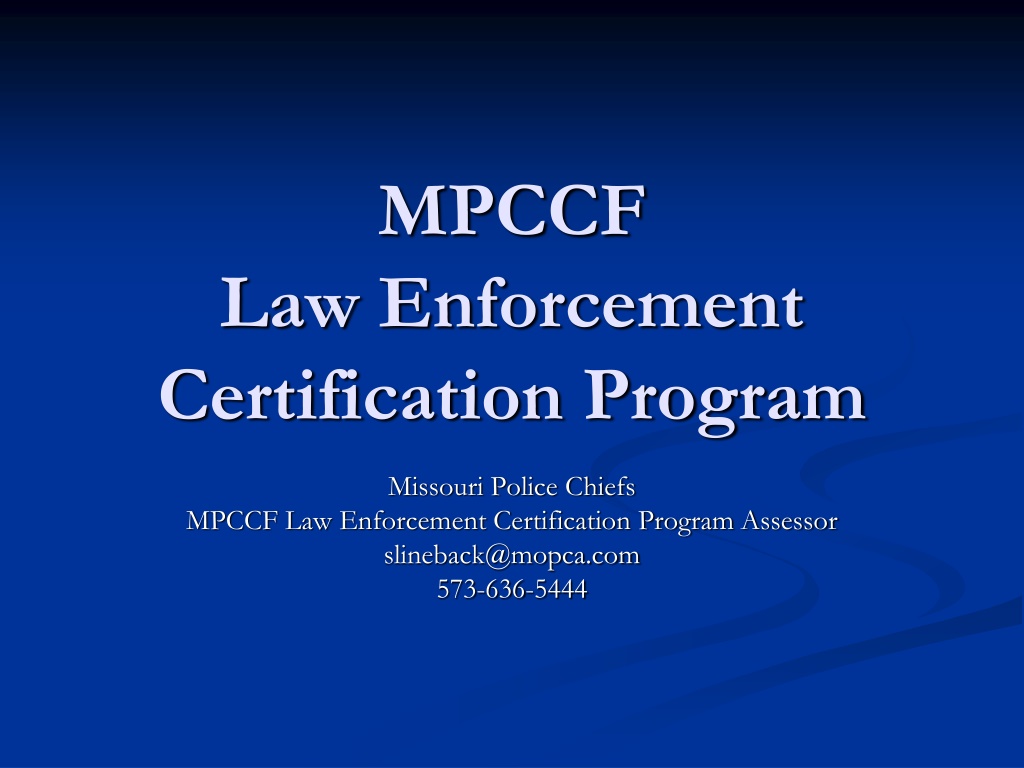
 undefined
undefined



